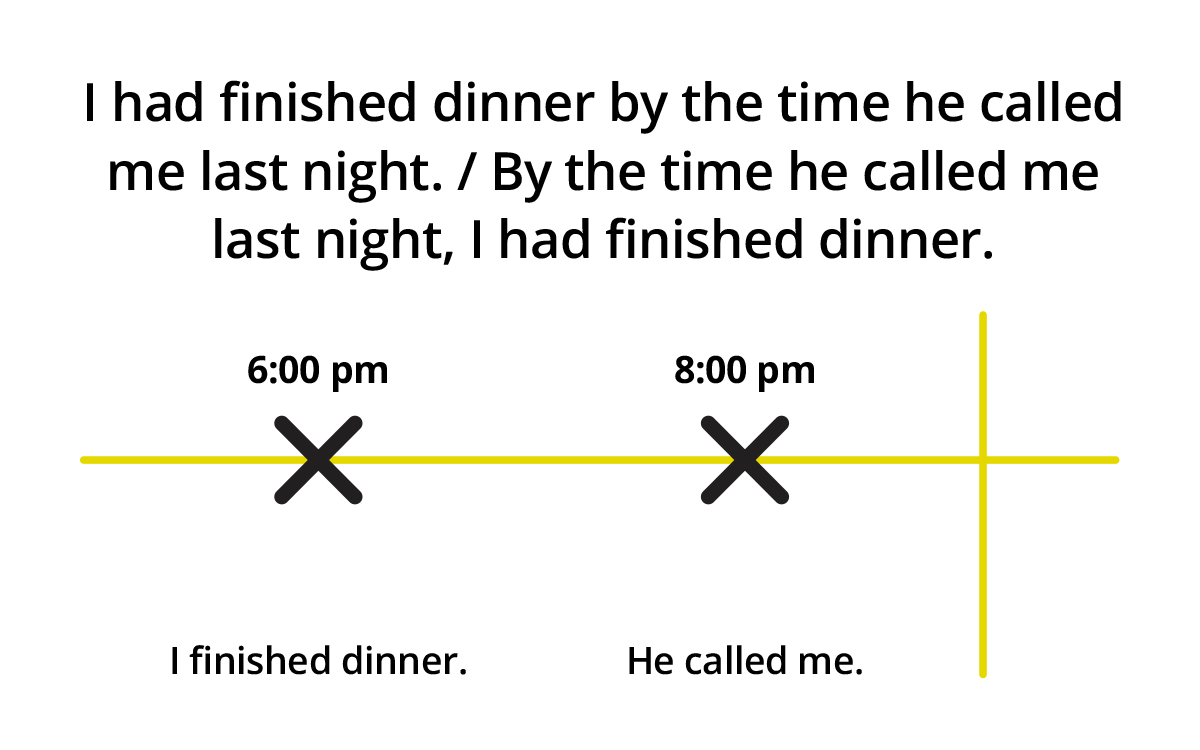Present Perfect Continuous Vs Past Perfect Progressive
After they studied verb tenses all week, the students had had enough grammar!
The past perfect often stumps students since it's not commonly used. The past perfect progressive, also known as the past perfect continuous, seems even more complicated! But these two verb tenses don't have to be a mystery to students. With the following helpful diagrams and chart, your students will be able to recognize and use these tenses when needed.
Past Perfect
HAD + P.P.
The past perfect is formed with the past auxiliary verb had and the past participle of the main verb. It is used when the first past action finishes before the second past action.

Past Perfect Progressive
HAD + BEEN + ‑ING VERB
The past perfect progressive is formed with the past auxiliary verb had, the past participle auxiliary verb been, and the present participle form (‑ing) of the main verb. It is used when the first past action continues until the second past action.

Note
If you want to elaborate for more advanced students, you can explain that the past perfect progressive is formed by combining the past perfect ( had + p.p. ) plus the basic progressive pattern ( be + ‑ing verb ). Since the past participle of the Be verb is been, you get had + been + ‑ing verb when combined.
Comparison Chart
To compare the two verb tenses and show your students examples, use the following verb chart. You can print out the chart and make photocopies, show them on the computer, or write it out on the board.

Past Perfect Vs. Past Perfect Progressive – Grammar & Usage
Important Note
When giving your students examples, it is very important to mix up the order of the independent and dependent clauses. Make sure that you give some examples where the independent clause comes first (with the past perfect or past perfect progressive), and others where the dependent clause comes first (with the simple past).
Point out that when the dependent clause comes first, students must use a comma between the clauses. Showing both types of examples means that students won't simply memorize "had + p.p. first, past verb second," which can cause errors.
Did You Know?
English speakers often don't bother with these complicated verb tenses, especially in informal speaking and writing. In most cases, you can substitute the simple past in place of the past perfect, and the past progressive in place of the past perfect progressive, with no change in meaning. Often the context or the time markers are enough to make the timing clear. Consider the following examples:
- My friend had texted me five times before I answered. (past perfect)
- My friend texted me five times before I answered. (simple past, same meaning)
- We had been waiting for two hours before she arrived. (past perfect progressive)
- We were waiting for two hours before she arrived. (past progressive, same meaning)
Practice
For more tips, examples, and practice exercises, try the Past Perfect and the Past Perfect Progressive lessons in the Grammar Practice Worksheets section. These lessons include mixed exercises that compare the past perfect and the past perfect progressive tenses as well as the past perfect with the simple past and present perfect.
For Fun
The Grammar Police shared this photo on Facebook a while ago. Try analyzing it with your students! See if they can figure out why it's grammatically correct to use four "hads" in a row in this sentence:All the faith he had had had had no effect on the outcome of his life.
Answer
Think of the first part of the sentence like this: He had had a lot of faith by the time he was an old man.
Think of the second part of the sentence like this: His faith had had no effect on the outcome of his life by the time he was an old man.
If you join them together, and the context of age is implied, then you can get this result: All the faith he had had [subject] had had [main verb] no effect [object] on the outcome of his life.
Source: https://ellii.com/blog/past-perfect-vs-past-perfect-progressive
0 Response to "Present Perfect Continuous Vs Past Perfect Progressive"
Post a Comment